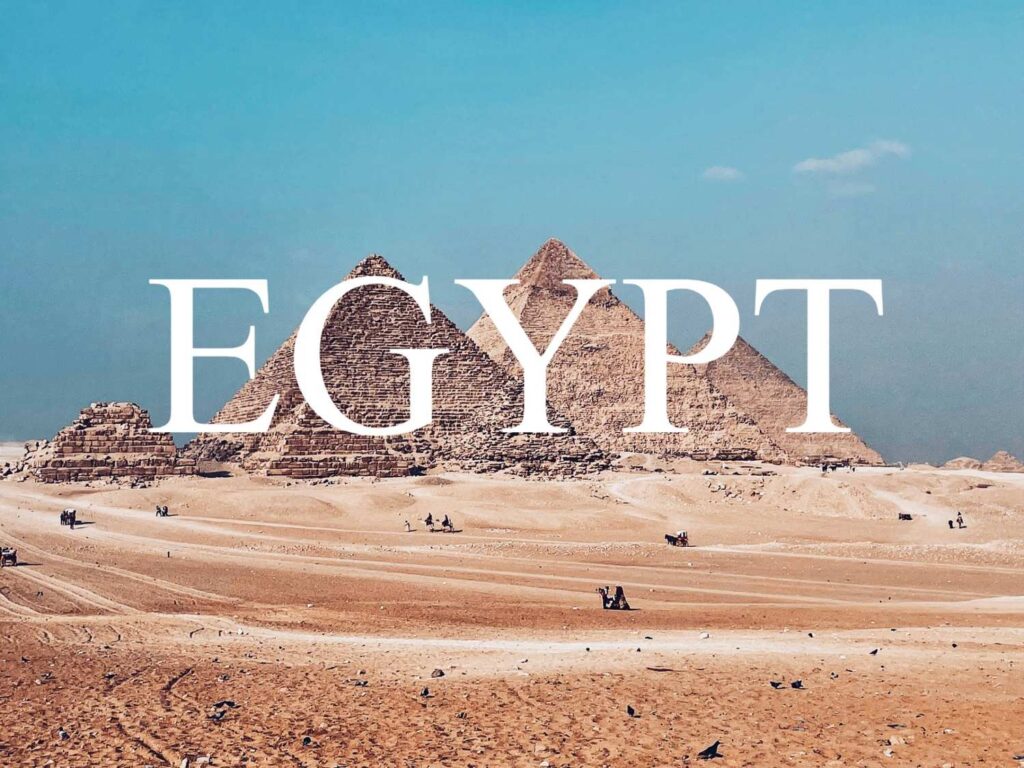
Egypt — the legendary land of pharaohs, pyramids, and timeless treasures — offers a spellbinding blend of ancient wonders, golden deserts, and vibrant modern culture. This North African gem invites travelers to walk in the footsteps of history while embracing the warmth and color of contemporary Egyptian life.
At the heart of it all flows the Nile River, the lifeblood of Egypt for thousands of years. A cruise along its waters takes you past lush riverbanks, traditional villages, and monumental sites like the Valley of the Kings, Luxor Temple, and Karnak, each whispering stories of a civilization that shaped the world.
No visit is complete without standing in awe before the Great Pyramids of Giza and the enigmatic Sphinx, marvels of engineering that continue to inspire wonder after millennia. In Cairo, dive into the chaos and charm of the city—explore the Egyptian Museum’s priceless artifacts, shop in the labyrinthine Khan El Khalili Bazaar, and admire Islamic architecture in the historic old city.
Beyond the ancient, Egypt also dazzles with natural beauty. From the serene Red Sea beaches of Hurghada and Sharm El Sheikh, perfect for diving and relaxation, to the peaceful Siwa Oasis and dramatic White Desert, the landscapes are as diverse as they are stunning.
Egyptian hospitality is as legendary as its history. You’ll be welcomed with sweet mint tea, rich local cuisine like koshari and ful medames, and stories that span generations. Whether you’re an adventurer, a history lover, or a cultural explorer, Egypt offers a journey like no other—timeless, thrilling, and deeply enriching.
🗓️ Best Time to Visit Egypt
- 🌤️ October to April (Cooler Season): The most comfortable time to explore Egypt, with temperatures ranging from 15°C to 25°C — ideal for sightseeing, desert adventures, and Nile cruises.
- ☀️ May to September (Hot Season): Very hot (up to 40°C or more), especially in southern Egypt and desert areas. It’s off-peak, so you’ll find fewer crowds and better hotel rates — but outdoor activities should be planned early in the day.
💵 Currency & Travel Essentials
- Currency: Egyptian Pound (EGP)
- Language: Arabic (English widely spoken in tourist areas)
- Transportation: Trains, domestic flights, Uber/taxis in cities, Nile cruises for travel between Luxor and Aswan
- Average Daily Budget:
- Budget: EGP 500–1,000
- Mid-range: EGP 1,200–2,500
- Luxury: EGP 3,000+
🏛️ 10 Best Places to Visit in Egypt
The Pyramids of Giza
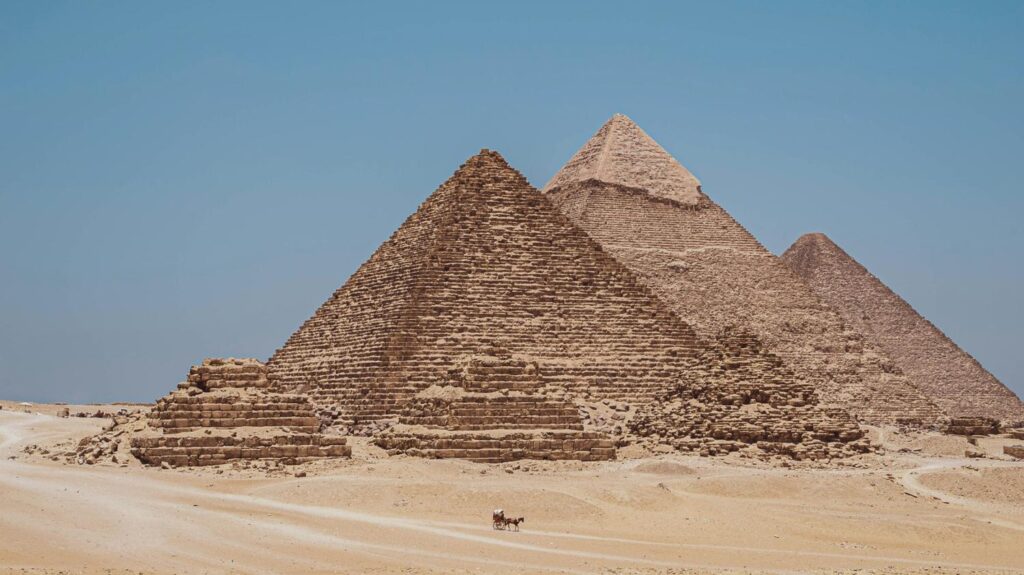
Standing proudly on the west bank of the Nile River in Giza, Egypt, the Pyramids of Giza are among the most iconic and awe-inspiring landmarks in the world. These ancient structures have stood the test of time for over 4,500 years and continue to captivate visitors with their grandeur, mystery, and historical significance. The Pyramids of Giza are not only an engineering marvel, but they also offer a glimpse into the grandeur of ancient Egyptian civilization, making them a must-see destination for travelers and history enthusiasts.
🌟 Highlights of The Pyramids of Giza
• ⛩️ The Great Pyramid of Giza (Pyramid of Khufu)
The largest of the three pyramids and one of the Seven Wonders of the Ancient World, the Great Pyramid is a breathtaking sight. Standing at an original height of 146.6 meters, it was the tallest man-made structure in the world for over 3,800 years. Visitors can explore its vast interior, including the King’s Chamber and Grand Gallery, to experience the scale and complexity of its construction.
• 🛕 Pyramid of Khafre
The second pyramid, built for Pharaoh Khafre, is slightly smaller than the Great Pyramid but is notable for its remaining limestone casing at the top. It is also home to the famous Great Sphinx of Giza, which sits in front of the pyramid, guarding the tomb with its majestic lion’s body and human head. The Sphinx is one of the world’s most recognized statues and has puzzled historians for centuries with its origin and purpose.
• 🔺 Pyramid of Menkaure
The smallest of the three pyramids, the Pyramid of Menkaure, is just as intriguing as its larger counterparts. While its size may be smaller, its complex structure and the tombs surrounding it still offer fascinating insights into ancient Egyptian burial practices. The mortuary temple and causeway connected to this pyramid are also remarkable features worth exploring.
• 🐱 The Great Sphinx of Giza
Located near the Pyramid of Khafre, the Great Sphinx is an iconic symbol of ancient Egypt. Carved from a single block of limestone, this lion-headed statue has captured the imagination of travelers and historians alike. Its exact purpose remains a mystery, but it is believed to have been constructed to protect the pyramids and the pharaoh’s tombs. Standing 20 meters high and 73 meters long, it’s an impressive sight, especially at sunrise or sunset.
• 🏺 The Solar Boat Museum
Near the Great Pyramid, visitors can explore the Solar Boat Museum, which houses a remarkably well-preserved wooden boat discovered at the foot of the pyramid. The boat was believed to be used by the pharaoh in the afterlife, symbolizing his journey into the afterlife. The boat is an incredible testament to the craftsmanship and spiritual beliefs of ancient Egypt.
• 🌅 Sunrise and Sunset Views
The pyramids are especially beautiful during sunrise and sunset when the changing colors of the desert and the pyramids create an almost magical atmosphere. Whether you are watching from the Giza Plateau or from a camel ride, the views at these times are unforgettable.
• 📚 Learn About Ancient Egypt
The Pyramid Complex also includes smaller tombs, the Valley Temple, and funerary temples that offer a glimpse into the religious and cultural practices of ancient Egypt. The Giza Museum nearby further enhances the experience, providing more context and artifacts related to the pyramids’ construction and purpose.
🚗 How to Get There
• By Car:
The Pyramids of Giza are located about 18 km from Cairo, making them easily accessible by car. A taxi ride from Cairo to Giza takes around 30 to 45 minutes depending on traffic.
• By Public Transport:
You can take a public bus or the Metro to Giza Station, and from there, take a short taxi ride to the pyramids. The Cairo Metro is affordable and connects well to the main attractions in the city.
• By Camel or Horseback:
For a more traditional and unique experience, you can also explore the pyramids on camel or horseback. There are numerous tour operators offering these rides, which provide an unforgettable perspective of the pyramids and surrounding desert landscape.
🕒 Visitor Information
• Opening Hours:
The Pyramids of Giza are open daily, usually from 8:00 AM to 5:00 PM. It’s recommended to arrive early in the morning to avoid crowds and to experience the pyramids in the cooler part of the day.
• Recommended Duration:
Plan to spend 3 to 4 hours at the pyramids to explore the site fully. This will give you time to visit the pyramids, the Sphinx, and the museum, as well as to enjoy the views and take in the surroundings.
💡 Travel Tips
• 👒 Wear Comfortable Clothing:
Egypt can get quite hot, especially during the summer months, so wear light clothing and comfortable shoes for walking on the rocky terrain. A hat and sunscreen are also essential.
• 💧 Stay Hydrated:
The desert climate can be quite dry, so be sure to carry a water bottle and stay hydrated as you explore the pyramids.
• 📸 Photography:
You’re welcome to take photographs at most parts of the pyramid complex, but be mindful of restricted areas, especially inside the pyramids. The Sphinx and the Great Pyramid offer excellent photo opportunities.
• 🕵️♂️ Hire a Guide:
While it’s possible to explore the pyramids on your own, hiring a local guide can enrich your experience. Guides can offer fascinating insights into the history, architecture, and cultural significance of the pyramids, as well as show you hidden gems on the site.
• 🌅 Visit at Sunrise or Sunset:
For the best views, visit the pyramids during sunrise or sunset when the lighting is softer, and the desert landscape is bathed in warm, golden hues. The experience is truly magical.
• 🐪 Camel Rides:
If you’re planning to take a camel ride, be sure to negotiate the price in advance. It’s also a good idea to confirm the duration of the ride before starting.
The Pyramids of Giza are one of the most remarkable achievements of human history and a testament to the skill, ingenuity, and spiritual beliefs of ancient Egyptians. Whether you’re exploring the monumental pyramids, gazing at the Great Sphinx, or learning about the island’s ancient culture, a visit to Giza is an unforgettable experience. Standing in the shadow of these ancient wonders, you’ll be awed by their timeless beauty and mystery, making it a bucket-list destination for travelers from around the globe.
Cairo & The Egyptian Museum
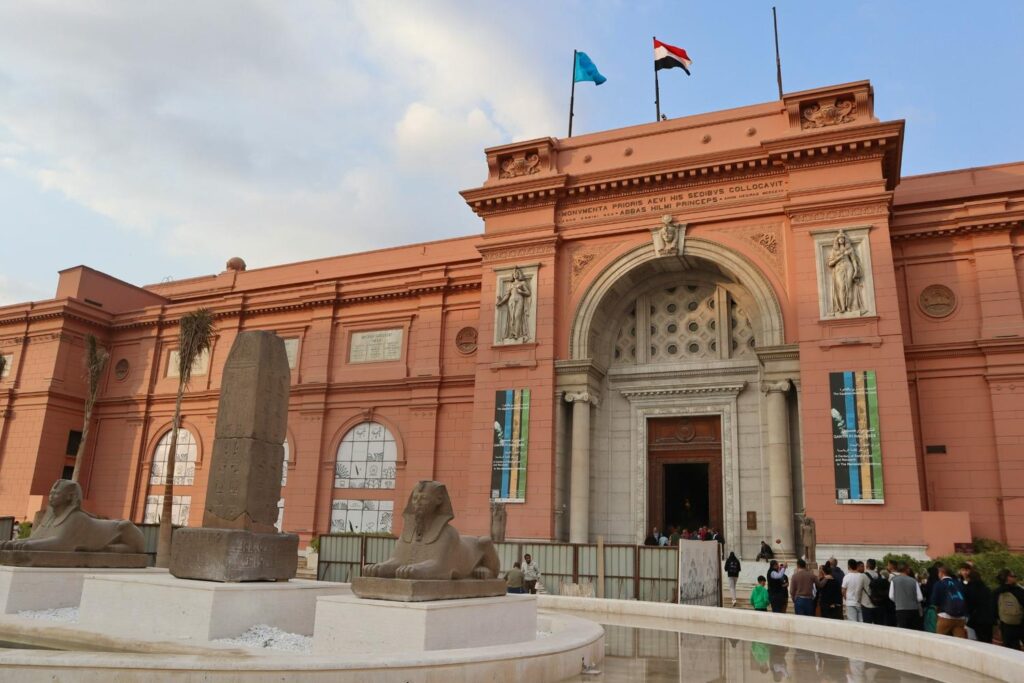
Photo by Dilip Poddar on Unsplash
Located in the heart of Egypt’s vibrant capital, Cairo, the Egyptian Museum is a treasure trove of ancient wonders, offering visitors a chance to explore the fascinating history and culture of one of the world’s oldest civilizations. Founded in 1902, this iconic museum houses over 120,000 artifacts, ranging from the Old Kingdom to the Ptolemaic Period. With its extensive collection, the Egyptian Museum is a must-visit for history buffs and anyone interested in discovering the secrets of Ancient Egypt.
🌟 Highlights of Cairo & The Egyptian Museum
🏺 King Tutankhamun’s Treasures
• The Golden Mask
The museum is home to the famous treasures of King Tutankhamun, the most well-known of Egypt’s pharaohs. The highlight is his stunning golden burial mask, a symbol of the ancient pharaoh’s grandeur and mystery. Other artifacts from Tut’s tomb, such as his chariot and jewelry, are also displayed.
🏛️ Ancient Artifacts
• The Mummies
The Egyptian Museum is famous for housing the royal mummies of pharaohs, queens, and nobility, including the remains of Ramses II and Hatshepsut. These preserved bodies offer a unique glimpse into ancient Egyptian burial practices and the art of mummification.
• Sculptures and Stelae
Admire the intricate sculptures, statues, and hieroglyphic-inscribed stelae that depict gods, pharaohs, and daily life in Ancient Egypt. Highlights include statues of Amenhotep III and the iconic Nefertiti bust.
🏺 Artifacts from the Old Kingdom
• Pyramid-era Art
Explore stone and wooden artifacts from the Old Kingdom, including statues of Khufu, Khafre, and Menkaure, the pharaohs behind the Great Pyramids of Giza. The museum’s collection provides valuable insights into the reigns of these monumental figures.
🖋️ The Museum’s Architecture
• Neoclassical Design
The Egyptian Museum’s neoclassical building is a landmark in Cairo. Its grand entrance and large collection halls house the museum’s impressive displays, offering a sense of awe and respect for the ancient world.
🎨 The Royal Jewelry Collection
• Exquisite Jewelry
The museum’s collection of royal jewelry is equally impressive, with ornate pieces worn by Egyptian royalty, including necklaces, diadems, and rings. The craftsmanship of these items showcases the luxury and artistry of ancient Egyptian culture.
🚗 How to Get There
• By Car: The Egyptian Museum is centrally located in Tahrir Square, one of Cairo’s most famous landmarks. The museum is easily accessible by car or taxi, and there is parking available nearby.
• By Metro: Sadat Station, located directly beneath Tahrir Square, is the closest metro station to the museum. The museum is just a short walk from the station.
• By Foot: If you are staying in central Cairo, the museum is within walking distance of many hotels, restaurants, and other cultural sites.
🕒 Visitor Information
• Opening Hours: The Egyptian Museum is open daily from 9:00 AM to 7:00 PM. It’s closed on official holidays and during special events, so check ahead.
• Admission Fees: Entry fees for the museum are around EGP 200-300 for foreign tourists. Extra charges may apply for the special mummies hall or photography permits.
• Recommended Visit Duration: To fully appreciate the museum’s extensive collection, it’s best to spend around 2 to 3 hours exploring the exhibits.
💡 Travel Tips
• 🎫 Book Tickets in Advance: The Egyptian Museum is a popular destination, so it’s a good idea to book your tickets online or in advance, especially during peak tourist seasons.
• 📷 Photography: While photography is allowed in most areas of the museum, you must purchase a photography permit for certain exhibits like the royal mummies.
• 👟 Wear Comfortable Shoes: The museum has large galleries, so comfortable footwear is recommended for walking through the vast collection.
• 📚 Take a Guided Tour: Consider hiring a local guide to provide historical context and fascinating stories behind the artifacts. Many guides offer private tours in multiple languages.
The Egyptian Museum is an unmissable cultural destination that brings to life the splendor and mysteries of Ancient Egypt. Its incredible collection of artifacts, from royal mummies to Tutankhamun’s treasures, offers an unparalleled journey into one of the world’s most fascinating civilizations. Whether you’re a history enthusiast or a first-time visitor to Cairo, this museum promises an awe-inspiring and educational experience. A visit here provides a deeper understanding of the ancient wonders that continue to captivate the world today.
Luxor & Karnak Temple
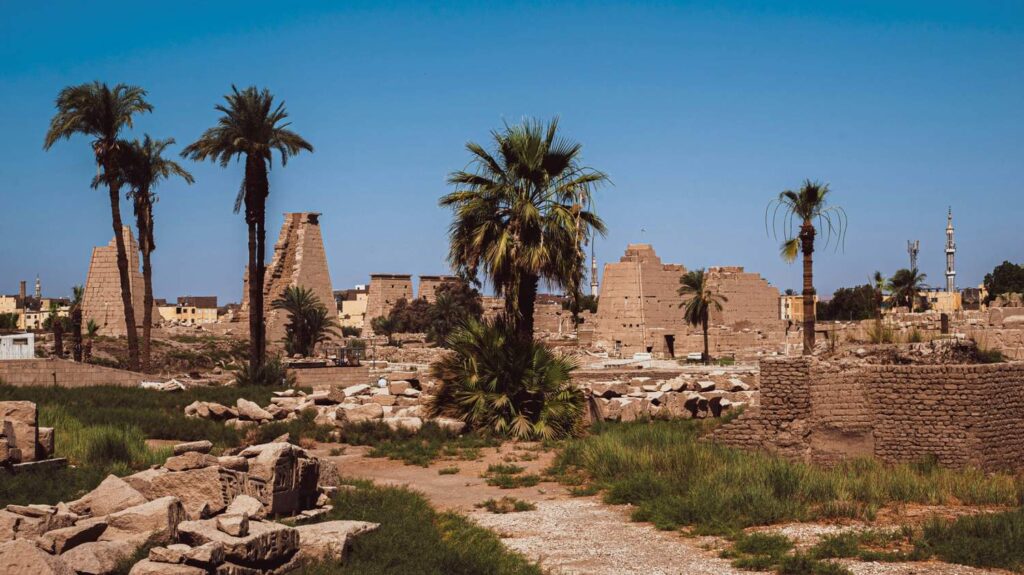
Situated on the east bank of the Nile River, the city of Luxor is often referred to as the world’s greatest open-air museum due to its vast array of ancient monuments. Among the most remarkable sites in Luxor is the Karnak Temple Complex, a sprawling religious site dedicated to the Theban Triad of gods – Amun, Mut, and Khonsu. With its awe-inspiring architecture, intricate hieroglyphs, and rich history, Luxor and Karnak provide an unforgettable journey into the heart of ancient Egypt’s glory.
🌟 Highlights of Luxor & Karnak Temple
• 🏛️ Karnak Temple Complex
The Karnak Temple is the largest religious complex in the world, covering an area of over 100 hectares. This magnificent site is a testament to the power and wealth of the ancient Egyptian pharaohs. Its most famous feature is the Hypostyle Hall, a vast room with 134 towering columns, each reaching up to 21 meters. The temple is adorned with detailed hieroglyphs and statues, depicting the achievements of past rulers and gods. Walking through the complex, you’ll feel like you’ve stepped back in time to the height of ancient Egyptian civilization.
• 🌅 The Avenue of Sphinxes
The journey to the Karnak Temple begins along the Avenue of Sphinxes, a magnificent path lined with hundreds of sphinx statues leading to the temple. This pathway, which connects Luxor Temple with Karnak, was used for the Opet Festival, an important religious event in ancient times. Walking along this avenue is a surreal experience, as the sphinxes, many of which have been recently restored, gaze down at you with silent wisdom.
• ⛩️ The Great Temple of Amun
At the heart of Karnak stands the Great Temple of Amun, the most significant part of the entire complex. Dedicated to the sun god Amun-Ra, this temple was enlarged and developed over centuries by different pharaohs, with monumental pylons, halls, and sanctuaries. The temple’s imposing structure is designed to symbolize the creation of the world, and its sheer size and grandeur are breathtaking.
• 🌞 The Sacred Lake
Karnak also features a serene sacred lake, where priests performed purification rituals. The lake was believed to have magical properties, and offerings to the gods were made here during important festivals. Visitors can now stroll along the lake’s edge and admire the serene setting, which provides a moment of tranquility amidst the grandeur of the temple.
• 🏺 Luxor Temple
While Karnak is the largest temple complex, Luxor Temple is equally impressive. Located in the heart of the modern city, Luxor Temple is known for its monumental entrance pylon, two massive obelisks (one of which is now in Paris at Place de la Concorde), and its grand courtyard. The temple is dedicated to Amun-Ra, and it was used for annual Opet Festival rituals. The evening light casts a magical glow over Luxor Temple, making it an unforgettable sight.
• 📜 The Sacred Texts and Hieroglyphs
Throughout the temples of Luxor and Karnak, you’ll find beautifully preserved hieroglyphs and inscriptions that provide a wealth of information about the beliefs, culture, and daily life of ancient Egyptians. The meticulous artwork that adorns the walls tells stories of kings, gods, and divine rituals, offering visitors an invaluable insight into ancient Egyptian civilization.
• 🌙 Sound and Light Show at Karnak
For an unforgettable experience, attend the Sound and Light Show at Karnak Temple in the evening. The temple is illuminated by lights as it is brought to life with dramatic narration, recreating the stories of ancient Egypt. The spectacle is set against the backdrop of the grand temple, creating a mystical atmosphere that’s perfect for history enthusiasts and first-time visitors alike.
🚗 How to Get There
• By Car:
Luxor is easily accessible by car from Cairo, approximately a 9-hour drive (or a short 1-hour flight). The Karnak Temple Complex and Luxor Temple are just a short distance from each other and can be easily reached by taxi or private car.
• By Public Transport:
You can also travel by train from Cairo to Luxor. The overnight sleeper trains are a popular option, offering comfort for the long journey. Upon arrival, taxis are readily available to take you to the temples.
• By Nile Cruise:
One of the most scenic ways to reach Luxor is by taking a Nile River cruise. Many cruises run between Aswan and Luxor, offering an immersive experience of Egypt’s ancient sites along the riverbanks.
🕒 Visitor Information
• Opening Hours:
The Karnak Temple is open daily from 6:00 AM to 5:00 PM, while Luxor Temple typically operates from 6:00 AM to 9:00 PM. The Sound and Light Show at Karnak usually begins at 7:00 PM or 8:00 PM, depending on the season.
• Admission Fee:
Entrance to the Karnak Temple and Luxor Temple costs approximately E£200-250 (Egyptian pounds) per site. The Sound and Light Show has a separate fee, which varies depending on seating options.
• Recommended Duration:
A visit to Karnak Temple can take around 2 to 3 hours, while Luxor Temple typically requires 1 to 2 hours. If you’re also planning to visit other sites in Luxor, such as the Valley of the Kings, you may want to allocate an entire day for exploring the area.
💡 Travel Tips
• 👒 Wear Comfortable Clothing:
The temples of Luxor and Karnak can be quite warm, especially during the summer months, so wear light, comfortable clothing and sunscreen. Don’t forget a hat or sunglasses for added protection from the sun.
• 💧 Stay Hydrated:
Egypt’s climate is hot and dry, so make sure to carry water with you as you explore. There are also a few places around the temples where you can purchase drinks and snacks.
• 📸 Photography:
Photography is allowed in most parts of the temples, but always check for any specific restrictions in certain areas. The hieroglyphs and sculptures provide incredible photo opportunities, so don’t forget your camera.
• 🕵️♂️ Hire a Guide:
While you can explore on your own, hiring a local guide will greatly enhance your experience. Guides can provide fascinating insights into the mythology, history, and symbolism of the temple, making your visit even more memorable.
• 🌙 Evening Visit to Luxor Temple:
Consider visiting Luxor Temple in the evening, when it is beautifully illuminated. The ambiance at night adds a sense of mystery and magic to the experience.
The Luxor & Karnak Temples are two of Egypt’s most extraordinary historical treasures. With their monumental structures, intricate artwork, and rich cultural heritage, these ancient sites offer a glimpse into the grandeur of the Egyptian civilization. Whether you’re standing in the shadow of the towering columns at Karnak or marveling at the elegance of Luxor Temple, these sites will leave you awe-struck by their timeless beauty and ancient majesty. A visit to Luxor is truly a journey through the heart of Egypt’s ancient wonders.
Abu Simbel Temples
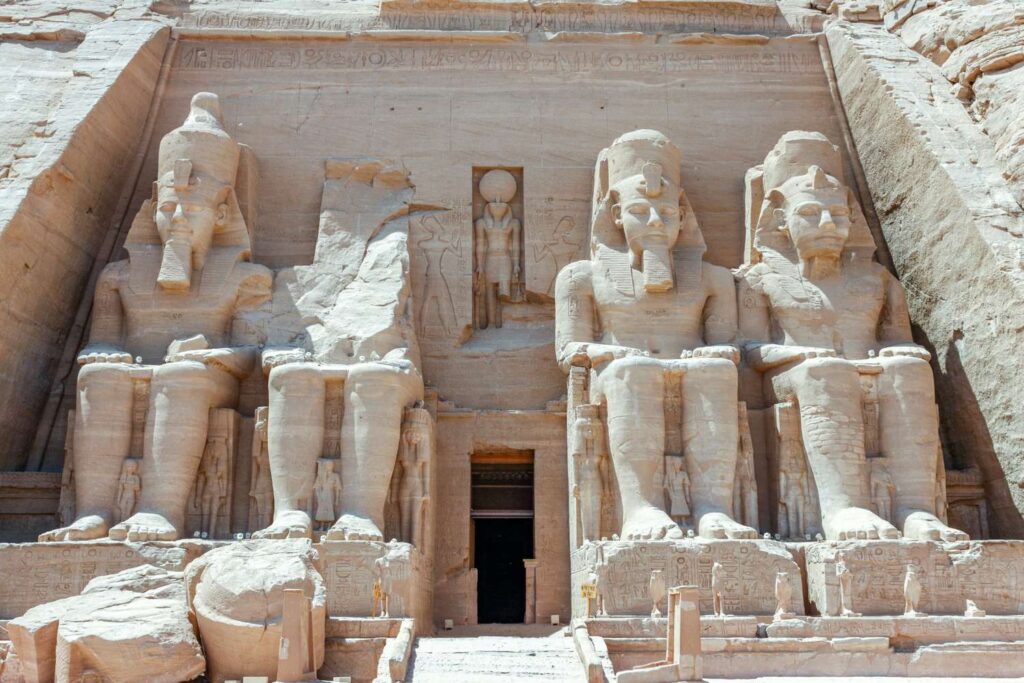
Photo by AussieActive on Unsplash
Located in the southern part of Egypt, near the Nubian border, the Abu Simbel Temples are some of the most awe-inspiring structures of the ancient world. Carved into the cliffs of the Aswan Governorate, these temples were built by Ramses II in the 13th century BCE, during the New Kingdom. The grandeur of Abu Simbel lies not only in its architectural brilliance but also in its historical significance and stunning location along the banks of the Nile River. The temples are a UNESCO World Heritage Site and one of Egypt’s most visited attractions.
🌟 Highlights of Abu Simbel Temples
🏛️ The Great Temple of Ramses II
• Iconic Colossal Statues
The Great Temple is the larger of the two Abu Simbel temples and is dedicated to Ramses II, the mighty pharaoh who ruled for 66 years. The entrance features four colossal statues of Ramses II, each standing 20 meters (66 feet) tall. These statues symbolize the pharaoh’s power and divine status and are one of the most recognizable images of Ancient Egypt.
• Grand Inner Sanctum
Inside the temple, the sanctum houses statues of Ramses II alongside those of gods like Ra-Horakhty, Amun, and Ptah. The walls are adorned with intricate carvings and inscriptions that depict Ramses’ military victories, including the famous Battle of Kadesh.
🏛️ The Temple of Hathor and Nefertari
• Dedicated to Hathor
The Temple of Hathor is the smaller of the two temples and is dedicated to Hathor, the goddess of love and motherhood, and Nefertari, Ramses II’s beloved queen. This temple features six towering statues at its entrance, two of which represent Ramses and Nefertari.
• Exquisite Reliefs and Carvings
Inside, the temple is filled with beautiful reliefs depicting scenes of the queen and the gods, showcasing the deep bond between Ramses II and Nefertari. The artwork also honors the goddess Hathor, with scenes of her welcoming the pharaoh.
🌞 Solar Alignment Phenomenon
• Sunrise Miracle
One of the most fascinating features of Abu Simbel is the solar alignment. Twice a year, on February 22 and October 22, the sunlight illuminates the inner sanctum of the Great Temple, shining directly on the statues of Ramses II and Amun. This alignment was intentionally designed by the ancient Egyptians to mark the pharaoh’s birthday and coronation day.
🌍 The Relocation of the Temples
• The Rescue Operation
In the 1960s, the construction of the Aswan High Dam threatened to submerge the temples under the waters of Lake Nasser. In an incredible feat of engineering, the temples were cut into blocks and reassembled 65 meters higher and 200 meters further inland, ensuring their preservation for future generations.
🚗 How to Get There
• By Plane: The closest airport is Abu Simbel Airport, which has flights from Cairo and Aswan. The flight takes around 1 hour and 30 minutes.
• By Car: Abu Simbel is about 290 kilometers (180 miles) from Aswan and takes around 3.5 to 4 hours by car. There are also organized tours that depart from Aswan.
• By Bus: Many tourists take a guided bus tour from Aswan to Abu Simbel, which typically departs early in the morning for a day trip
🕒 Visitor Information
• Opening Hours: Abu Simbel Temples are open daily from 6:00 AM to 5:00 PM. It’s recommended to visit early in the day to avoid the crowds and the heat.
• Admission Fees: Entry to the temples is approximately EGP 200 for foreign tourists, with additional charges for photography permits.
• Recommended Visit Duration: A visit typically lasts 2 to 3 hours, which gives you enough time to explore both temples and take in the surrounding views.
💡 Travel Tips
• 🎫 Book Tours in Advance: Consider booking a guided tour or package tour that includes transportation from Aswan to Abu Simbel, as the site is somewhat remote.
• 🌞 Prepare for the Heat: The weather in the desert can be very hot, especially in summer. Be sure to bring sun protection (hat, sunscreen), plenty of water, and wear comfortable shoes for walking.
• 📷 Photography: Photography is allowed in most parts of the temple, but there may be restrictions on certain artifacts or areas.
• 🚗 Early Arrival: Try to arrive early in the morning to avoid the midday heat and to experience the temples before the crowds arrive.
The Abu Simbel Temples are a testament to the ingenuity and grandeur of Ancient Egypt. Their majestic statues, intricate carvings, and the phenomenon of solar alignment make them one of the most iconic and awe-inspiring archaeological sites in the world. Whether you’re a history enthusiast, a photographer, or a traveler seeking to connect with the ancient past, Abu Simbel offers an unforgettable experience. Don’t miss the opportunity to witness these monumental structures that have withstood millennia of history, and to learn about the incredible feat of their relocation to preserve Egypt’s rich heritage.
Aswan & Philae Temple
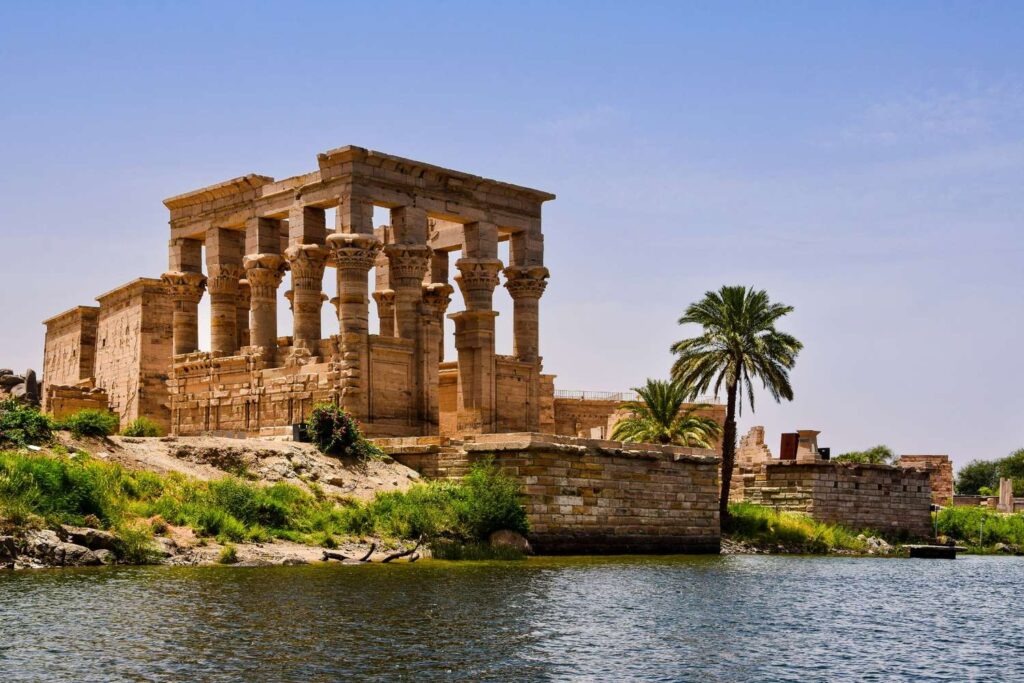
Photo by AXP Photography on Unsplash
Nestled along the Nile River, Aswan is one of Egypt’s most picturesque cities, known for its tranquil beauty, vibrant culture, and rich history. At the heart of this historic city lies the Philae Temple, a stunning monument dedicated to the goddess Isis. A visit to Aswan is incomplete without exploring this ancient temple complex, which offers a glimpse into Egypt’s mythology, architecture, and the divine worship practices of the ancient Egyptians.
🌟 Highlights of Aswan & Philae Temple
• 🏛️ Philae Temple – A Temple to the Gods
The Philae Temple is an iconic Egyptian temple complex situated on an island in the Nile River. Dedicated to the goddess Isis, the temple was once part of a larger religious site, but it was relocated to its current location in the 1970s to protect it from the rising waters of the Aswan High Dam. This stunning temple features beautiful carvings and reliefs depicting the myths surrounding the goddess Isis and her role in Egyptian spirituality. Key highlights include the hypostyle hall, the Sanctuary of Isis, and the Kiosk of Nectanebo II, all of which are richly adorned with intricate hieroglyphs.
• 🌊 Boat Ride to Philae Temple
The journey to Philae Temple is as magical as the temple itself. Visitors take a short boat ride across the Nile to reach the temple island, offering a scenic view of the river and surrounding landscape. The boat ride provides a peaceful and beautiful start to the visit, making it a serene and memorable experience.
• 🌅 Views of the Nile and Nubian Culture
Aswan is renowned for its stunning views of the Nile River and the surrounding landscape. The Nubian villages along the riverbanks add an authentic touch to the region, where you can see colorful houses and experience Nubian culture. The island where Philae Temple is located also offers picturesque panoramas, making it a great spot for photography.
• 🌞 The Temple of Isis
The main temple, dedicated to Isis, the mother goddess, is the most remarkable feature of the Philae complex. Isis was widely worshipped across ancient Egypt, and her temple here was one of the most significant sites for religious pilgrimages. The temple’s walls are adorned with intricate reliefs depicting the goddess and her mythological significance, particularly in the tales of Osiris and Horus. It’s a serene and awe-inspiring space to explore, with spiritual energy that still lingers in the air.
• 🏺 The Kiosk of Nectanebo II
A remarkable feature of the Philae Temple is the Kiosk of Nectanebo II, a beautifully preserved structure that stands proudly at the entrance. Built during the 30th Dynasty, it is a rare example of classical Egyptian architecture, with columns that have stood the test of time.
• 📜 The Sacred Lake
Near the temple, you’ll find the Sacred Lake, a part of the ancient complex where rituals and offerings to the gods were performed. The serene waters of the lake are flanked by stone steps, and the peaceful environment adds to the mystical atmosphere of the entire site.
• 🌙 Sound and Light Show at Philae Temple
For a truly magical experience, consider attending the Sound and Light Show at Philae Temple. As the sun sets and darkness envelops the island, the temple is illuminated by dramatic lighting, and the captivating sound and narration bring to life the ancient myths of Isis, Osiris, and Horus. This evening show provides a deeper connection to the temple’s history and spiritual significance.
🚗 How to Get There
• By Car:
Aswan is easily accessible by car from Cairo (approximately 12 hours by road) or by plane (about a 1-hour flight). Once in Aswan, the Philae Temple is a short drive from the city center, followed by a boat ride to the island.
• By Public Transport:
The Aswan train station has direct connections to Cairo and other major cities in Egypt. From the train station, taxis are readily available to take you to the boat dock, where you can catch a ride to Philae Temple.
• By Boat:
For a more scenic and relaxed option, you can take a Nile cruise from Luxor to Aswan, passing by ancient monuments along the river and reaching Aswan in style.
🕒 Visitor Information
• Opening Hours:
Philae Temple is open daily from 8:00 AM to 5:00 PM, with extended hours for the Sound and Light Show in the evening.
• Admission Fee:
The entrance fee for Philae Temple is approximately E£100-150 (Egyptian pounds). There’s a separate fee for the Sound and Light Show, which is around E£200 (Egyptian pounds).
• Recommended Duration:
You should plan to spend at least 2 to 3 hours at Philae Temple to explore the complex, take the boat ride, and fully appreciate its beauty and historical significance.
💡 Travel Tips
• 👒 Wear Comfortable Clothing:
Egypt’s sun can be intense, so wear light, breathable clothing and comfortable shoes for exploring the temple complex. Sunscreen and a hat are highly recommended.
• 💧 Stay Hydrated:
The desert heat can be overwhelming, so make sure to bring a water bottle and stay hydrated as you explore the temple island.
• 📸 Photography:
Photography is allowed in most parts of the temple, so be sure to bring your camera. The boat ride, temple architecture, and surrounding landscapes offer plenty of photo opportunities.
• 🎟️ Buy Tickets in Advance:
If you plan to attend the Sound and Light Show, consider purchasing tickets in advance to ensure availability, especially during peak tourist seasons.
• 🚣♂️ Take the Boat Ride:
The boat ride to Philae Temple is an integral part of the experience. Make sure to enjoy the scenic views along the Nile, and if you can, try to sit on the upper deck for a better vantage point.
A visit to Aswan & Philae Temple offers a rare opportunity to step into the heart of ancient Egyptian spirituality and architectural grandeur. The journey through the Nile to the island, combined with the stunning temple complex itself, makes this a truly magical experience. Whether you’re a history buff, an architecture enthusiast, or someone in search of tranquility, Aswan and Philae Temple will undoubtedly leave you in awe of the ancient wonders that continue to captivate the world.
The Nile River Cruise
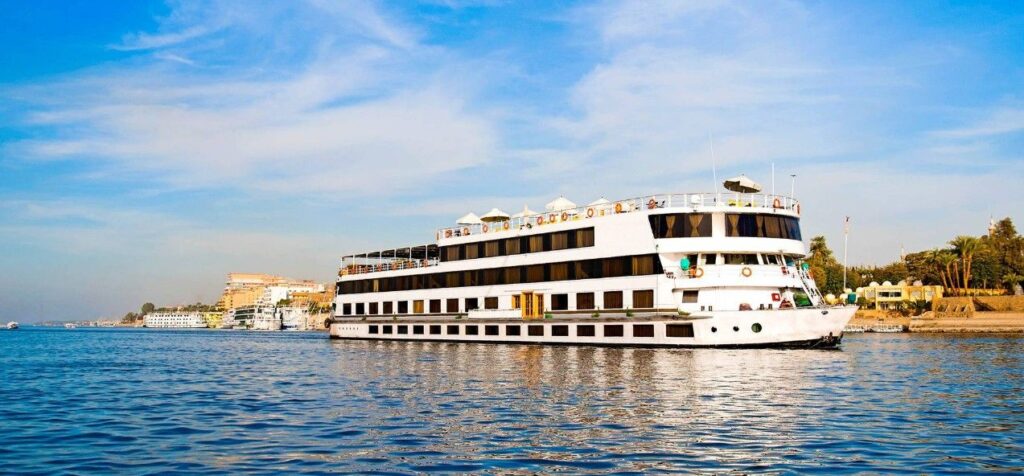
A Nile River Cruise is one of the most enchanting ways to experience the grandeur of Egypt’s ancient civilization. Flowing through the heart of the country, the Nile has been the lifeblood of Egyptian culture for thousands of years. A cruise along this iconic river offers a unique and scenic way to explore Egypt’s most famous historical sites, from the Pyramids of Giza to the temples of Luxor and beyond. Whether you choose a luxurious multi-day cruise or a shorter excursion, the Nile River promises an unforgettable adventure through history, culture, and natural beauty.
🌟 Highlights of The Nile River Cruise
🏛️ Luxor and Karnak Temples
• Temple of Luxor
A stop in Luxor will introduce you to some of Egypt’s most remarkable monuments. The Temple of Luxor is an awe-inspiring structure dedicated to the Theban Triad. Explore its towering columns, majestic statues, and the famous Avenue of Sphinxes.
• Karnak Temple
The Karnak Temple complex is one of the largest and most spectacular temple complexes in the world. Its hypostyle hall, with over 130 massive columns, and the sacred lake are major highlights.
🏺 Valley of the Kings and Queens
• Tomb of Tutankhamun
A visit to the Valley of the Kings will take you to the royal burial grounds of ancient pharaohs, including the tomb of the famous King Tutankhamun. The stunning reliefs and treasures found in these tombs offer a glimpse into the afterlife beliefs of Ancient Egypt.
• Valley of the Queens
Not far from the Kings’ tombs, the Valley of the Queens is the burial site of pharaohs’ wives and royal children. The Tomb of Nefertari, with its vibrant frescoes, is particularly famous.
🌅 Edfu and Kom Ombo Temples
• Temple of Edfu
The Temple of Edfu is dedicated to the god Horus and is one of the best-preserved temples in Egypt. Its grand pylons, reliefs, and the sanctuary are impressive and give a fascinating insight into Egyptian religious practices.
• Temple of Kom Ombo
Situated on the banks of the Nile, the Kom Ombo Temple is dedicated to the gods Horus and Sobek (the crocodile god). Its unique double temple design is a rare feature in ancient Egyptian architecture.
🚢 Scenic Views of the Nile
• The River’s Beauty
While on the cruise, you’ll enjoy breathtaking views of the Nile’s lush banks. Picture traditional sailboats (feluccas) gliding by, local villages, and the desert landscape that seems to stretch endlessly on both sides of the river.
🏙️ Cairo and the Pyramids
• Giza Pyramids
While not directly accessible from the cruise route, a Nile River journey often begins or ends in Cairo, where you can visit the Pyramids of Giza, the Sphinx, and the Egyptian Museum to explore the heart of ancient Egyptian civilization.
🚗 How to Get There
• By Plane: Flights from Cairo to Luxor or Aswan are quick and affordable, with the most popular cruise routes departing from Luxor or Aswan.
• By Train: Trains from Cairo to Luxor or Aswan are available and can be a scenic way to reach the starting points of the cruise, though it takes longer.
• By Road: You can take a road trip from Cairo to Luxor, which takes about 9 hours by car. This is often included in guided tour packages.
🕒 Visitor Information
• Cruise Duration: A typical Nile River cruise lasts anywhere from 3 to 7 days, depending on the route and number of stops. Longer cruises may include stops further south to Abu Simbel.
• Best Time to Visit: The best time for a Nile River cruise is between October and April when the weather is cooler. Summer months (June-August) can be extremely hot.
• Rates: Prices for Nile cruises vary widely depending on the ship’s amenities, cruise duration, and the season. Luxury cruises tend to be more expensive, while budget options are available for a more affordable experience.
💡 Travel Tips
• 📸 Bring a Camera: The sunsets over the Nile are magical, and the temples and ruins along the banks are some of the most photogenic sites in Egypt. Don’t forget extra batteries and memory cards!
• 🌞 Prepare for Heat: While the cruise offers comfort, be sure to pack light clothing, sunscreen, and a hat. The sun can be intense during the day.
• 🎟️ Book in Advance: Nile cruises are popular, especially during peak tourist seasons, so it’s wise to book in advance to secure your spot on the boat of your choice.
• 🍽️ Dining Onboard: Most Nile cruise ships offer all-inclusive meals, featuring traditional Egyptian dishes as well as international options. Some ships also offer themed dinner nights, which are a fun way to immerse yourself in the culture.
• 💧 Stay Hydrated: The heat can be intense, so drink plenty of water throughout the day to stay hydrated.
A Nile River Cruise offers a once-in-a-lifetime opportunity to experience the spirit of Egypt from a unique vantage point. With stops at iconic temples, tombs, and archaeological wonders, it provides a perfect balance of relaxation and exploration. Whether you’re floating along the river, soaking up the cultural heritage, or marveling at the ancient monuments, a Nile cruise is an unforgettable adventure that brings you closer to the heart of one of the world’s oldest and most captivating civilizations.
White Desert (Sahara el Beyda)
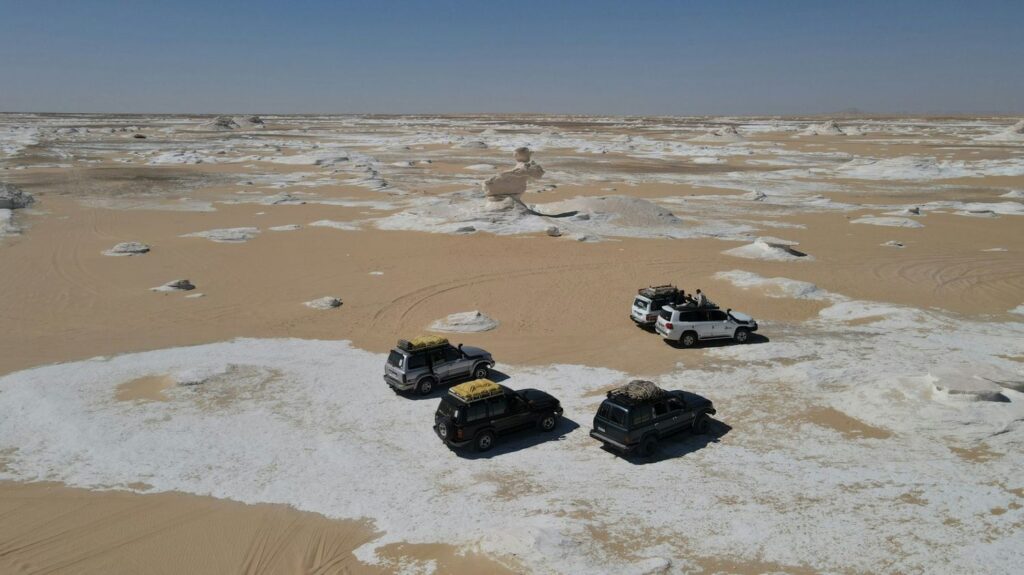
Photo by Ahmed Azab on Unsplash
Tucked away in the heart of Egypt’s Western Desert, the White Desert or Sahara el Beyda is one of the most surreal and otherworldly landscapes on the planet. Known for its striking white limestone formations, this vast desert offers a unique blend of stark beauty and tranquil isolation. Whether you’re an adventure seeker, a nature lover, or someone searching for a peaceful retreat, the White Desert is a must-see destination that promises an unforgettable experience.
🌟 Highlights of the White Desert (Sahara el Beyda)
• 🏜️ Unique White Limestone Formations
The White Desert is most famous for its surreal chalky white rock formations, which have been sculpted by centuries of wind erosion. These natural sculptures resemble bizarre shapes such as mushrooms, pillars, dunes, and even animals. The sheer white expanse creates an almost dreamlike atmosphere, where visitors feel as though they have stepped into a completely different world.
• 🌅 Sunrise and Sunset Views
One of the best times to visit the White Desert is during the early morning or late afternoon, when the sunlight casts dramatic shadows over the white landscape. The golden hues of the sun as it rises or sets over the desert are a photographer’s dream and create an ethereal beauty that is difficult to capture anywhere else in the world.
• 🌌 Stargazing
Thanks to its remote location and minimal light pollution, the White Desert is one of the best places in Egypt to stargaze. When night falls, the desert sky comes alive with thousands of stars, offering a mesmerizing and peaceful experience. The contrast between the stark white sand and the dark sky makes this a perfect spot for night photography or simply to marvel at the vastness of the universe.
• 🏕️ Camping in the Desert
A popular way to experience the White Desert is by staying in a desert camp overnight. Many tours offer guided camping trips, where you can enjoy a traditional bedouin-style dinner under the stars, listen to desert stories, and fall asleep surrounded by the calmness of the desert. This is a great way to immerse yourself in the beauty and tranquility of the Sahara el Beyda.
• 🌿 Desert Flora and Fauna
Though the White Desert may seem barren at first glance, it is home to a surprising variety of desert flora and fauna. Visitors may spot desert foxes, sand gazelles, and fennel plants among the rock formations. The desert’s unique ecosystem thrives despite the harsh conditions, and a knowledgeable guide can point out the various species that inhabit this arid environment.
• 💫 The Black Desert
Just a short drive from the White Desert lies the Black Desert, another striking desert landscape where volcanic hills and black stones dominate the terrain. The contrast between the white and black deserts offers an even more striking view of the desert’s diverse beauty. Exploring both deserts in one trip is highly recommended for those seeking a varied and complete desert experience.
• 🌍 Historical Significance
The White Desert is part of the larger Western Desert, which has long been a crossroads of trade and migration. The desert was used by ancient Egyptians and Bedouins as a trading route and resting place. Evidence of past settlements, ancient tombs, and remnants of prehistoric life can still be found scattered across the region.
🚗 How to Get There
• By Car:
The White Desert is approximately 5 to 6 hours by car from Cairo. The road journey is part of the adventure, as you pass through Egypt’s remote desert landscape. Most visitors travel through Bahariya Oasis or Farafra Oasis before reaching the White Desert. It’s highly recommended to travel with a local guide or as part of an organized tour, as the area can be difficult to navigate.
• By Tour Group:
There are several tour operators in Cairo and Luxor that offer guided trips to the White Desert. Many of these tours include transportation, meals, a local guide, and camping equipment, making it an easy way to experience the desert with minimal hassle.
• By Air:
While there is no commercial airport in the White Desert itself, you can fly into Cairo and then continue your journey by road to the desert. Alternatively, you can fly to Bahariya Oasis, which is the closest major town to the White Desert.
🕒 Visitor Information
• Opening Hours:
The White Desert is open year-round, though the best time to visit is from October to April, when the temperatures are milder. During the summer months (May to September), the desert can be extremely hot, with temperatures regularly exceeding 40°C (104°F).
• Admission Fee:
There is no official entrance fee for the White Desert, but if you’re visiting as part of a guided tour, expect to pay for transportation, meals, and accommodations. The cost of these tours can vary based on duration and services offered.
• Recommended Duration:
A typical visit to the White Desert lasts 2 to 3 days, including travel time and an overnight stay in a desert camp. However, if you’re on a tight schedule, a day trip from Cairo is also an option, though it will be more rushed.
💡 Travel Tips
• 🧳 Pack for the Desert:
Temperatures in the desert can fluctuate drastically. While it’s hot during the day, it can get very cold at night, especially in the winter months. Bring layers of clothing, including warm attire for the evening. Comfortable sand-resistant shoes are also recommended.
• 💧 Stay Hydrated:
The desert environment can be very dry and hot, so make sure to bring plenty of water. Staying hydrated is crucial when exploring such a harsh environment.
• 🌅 Watch the Sunrise and Sunset:
The sunrise and sunset over the White Desert are among the most beautiful experiences you can have in Egypt. Be sure to wake up early or stay out late to witness these magical moments. Bring a camera to capture the otherworldly glow of the desert.
• 🚶♂️ Take It Slow:
Desert environments can be physically demanding, so pace yourself and take plenty of breaks while exploring. Walking through the soft sand and climbing over the rock formations can be exhausting, especially in the heat.
• 🌙 Respect Local Customs:
The desert is home to various Bedouin tribes who live in the region. While you may not encounter many people on your trip, it’s important to respect their way of life and ask for permission if you plan to photograph them or their homes.
The White Desert (Sahara el Beyda) is a place of raw, untouched beauty that feels like another world. From the stunning white limestone formations to the magical desert landscapes, this is a destination for those who seek adventure, tranquility, and awe-inspiring natural wonders. Whether you’re camping under the stars, stargazing at night, or marveling at the sun’s glow on the white sand, a visit to the White Desert is an unforgettable experience that will leave you with memories to last a lifetime.
Alexandria
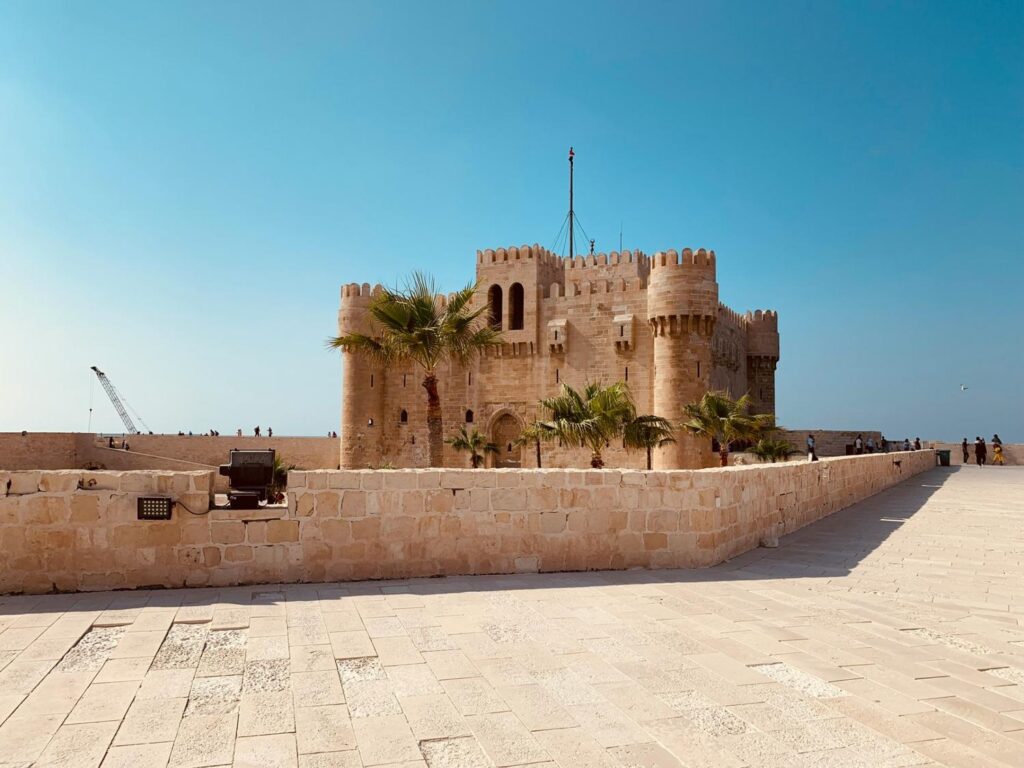
Photo by Farah Samy on Unsplash
Nestled on the northern coast of Egypt, Alexandria is a city steeped in history, culture, and natural beauty. Founded by Alexander the Great in 331 BCE, Alexandria has served as a beacon of ancient learning and Mediterranean trade for centuries. The city combines the allure of a historic port city with the modern vibe of a cosmopolitan destination. From its ancient ruins to its stunning waterfront, Alexandria offers a unique glimpse into Egypt’s past and its vibrant present.
🌟 Highlights of Alexandria
🏛️ The Library of Alexandria
• Ancient Intellectual Hub
One of the most famous landmarks in Alexandria, the Library of Alexandria was once the largest and most significant library of the ancient world. Though the original library was destroyed, a modern Bibliotheca Alexandrina now stands as a symbol of knowledge and learning, housing millions of books and manuscripts from around the globe.
• Museum & Exhibitions
The modern library also contains museums, galleries, and exhibition spaces dedicated to the history and culture of Alexandria and Egypt. Don’t miss the Ancient Egyptian Museum inside.
⚓ The Corniche & Waterfront
• Breathtaking Views
Strolling along the Corniche, the city’s scenic waterfront promenade, you’ll be treated to beautiful views of the Mediterranean Sea. The Corniche is lined with cafes, restaurants, and historic landmarks, making it the perfect place to relax, people-watch, or enjoy a sea breeze.
• Qaitbay Citadel
At the far end of the Corniche, the Qaitbay Citadel stands tall, offering sweeping views of the sea and the city. Built in the 15th century on the site of the ancient Pharos Lighthouse, one of the Seven Wonders of the Ancient World, the citadel is a stunning example of Islamic military architecture.
🏺 The Catacombs of Kom el Shoqafa
• Underground Ancient Tombs
The Catacombs of Kom el Shoqafa are a fascinating burial site and one of the Seven Wonders of the Middle Ages. These ancient tombs feature a blend of Egyptian, Greek, and Roman architectural styles, and visitors can explore the intricate network of chambers and burial passages.
• Roman Influence
The catacombs provide valuable insight into the Roman period of Alexandria, with stunning reliefs, statues, and sarcophagi adorning the walls.
🌅 Montaza Palace and Gardens
• Royal Elegance
The Montaza Palace, set in lush gardens, was once the royal residence of Egypt’s ruling family. The palace is surrounded by beautifully landscaped gardens and offers a peaceful escape from the bustling city. The location by the sea adds to its charm, providing panoramic views of Alexandria’s coastline.
• Public Gardens
The Montaza Gardens are open to the public, and visitors can stroll through manicured lawns, enjoy the shade of tall palm trees, and relax by the sea.
🏛️ Roman Amphitheatre
• A Peek into Roman Alexandria
The Roman Amphitheatre in Alexandria is a well-preserved ancient venue, where Romans would enjoy performances, games, and public events. The amphitheater, with its marble seats and open-air design, offers visitors a glimpse into the city’s once-thriving Roman presence.
🏰 Pompey’s Pillar and Serapeum
• Ancient Monument
Pompey’s Pillar is one of Alexandria’s most iconic landmarks. Standing at 28 meters tall, it is the largest ancient Roman pillar still standing in Egypt. The pillar is part of the Serapeum, a temple dedicated to the god Serapis, and marks the site of an ancient library and worship center.
🚗 How to Get There
• By Plane: Alexandria is home to Borg El Arab International Airport, which is about 45 km from the city center. Flights to Alexandria can be booked directly from Cairo or other major Egyptian cities, as well as some international destinations.
• By Train: Alexandria is easily accessible from Cairo by train. The train ride takes around 2.5 to 3 hours, offering a comfortable and scenic journey along the coast.
• By Car: Driving from Cairo to Alexandria is a popular option, taking around 2.5 hours via the Desert Road or the Coastal Road.
🕒 Visitor Information
• Opening Hours: Alexandria’s attractions have varying hours. Qaitbay Citadel and the Catacombs of Kom el Shoqafa generally open from 8:00 AM to 4:00 PM, while the Montaza Palace is typically open from 9:00 AM to 5:00 PM.
• Admission Fees: Entrance fees for popular sites like the Library of Alexandria and Qaitbay Citadel are affordable. The cost typically ranges from EGP 40 to 100, with discounts for students.
• Recommended Visit Duration: Plan to spend 2 to 3 days in Alexandria to fully experience the key sites. If you’re short on time, you can visit the major attractions in one day.
💡 Travel Tips
• 📸 Photography: Photography is allowed in most areas, but be aware that some sites may have restrictions or require an additional fee for photography.
• 🌞 Dress Comfortably: Alexandria can be warm, especially in summer. Wear lightweight clothing, comfortable shoes, and carry sunscreen and water with you.
• 🚶♂️ Explore on Foot: The city is best explored on foot or via a short taxi ride. Many attractions, like the Corniche and Qaitbay Citadel, are within walking distance of each other.
• 🍽️ Try Local Cuisine: Don’t miss tasting Alexandria’s seafood dishes, especially fresh fish and seafood platters. The city is known for its Mediterranean-inspired cuisine, blending Egyptian flavors with Greek and Italian influences.
Alexandria is a city where the ancient world meets modernity, offering visitors a rich tapestry of history, culture, and Mediterranean charm. Whether you’re exploring its ancient ruins, strolling along the Corniche, or enjoying the beautiful gardens and palaces, Alexandria offers something for every traveler. Its captivating mix of ancient heritage and coastal beauty makes it a must-visit destination for those wanting to experience the true essence of Egypt beyond the Pyramids.
Hurghada & the Red Sea Coast
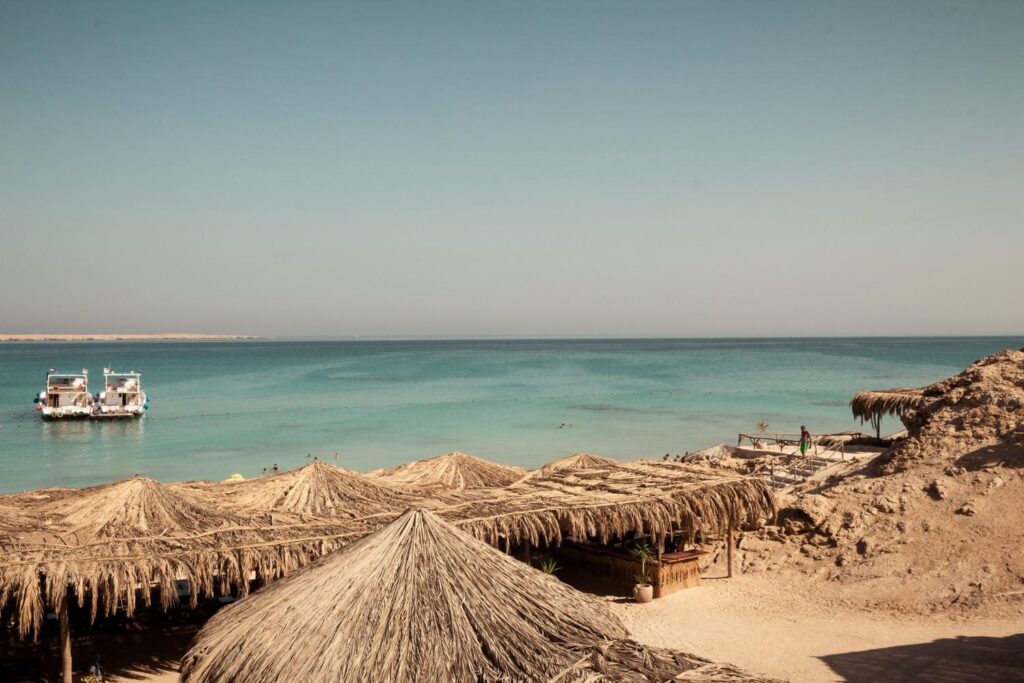
Photo by Kévin et Laurianne Langlais on Unsplash
Nestled along the sparkling waters of the Red Sea, Hurghada is one of Egypt’s most popular beach resorts, offering the perfect blend of sun, sea, and adventure. This vibrant coastal city, with its pristine beaches, crystal-clear waters, and vibrant coral reefs, has become a top destination for travelers seeking relaxation and water sports. Whether you’re interested in diving, snorkeling, exploring desert landscapes, or simply soaking up the sun, Hurghada and the surrounding Red Sea Coast offer a truly unforgettable experience.
🌟 Highlights of Hurghada & the Red Sea Coast
• 🌊 World-Class Diving and Snorkeling
The Red Sea is famous for its extraordinary underwater world, and Hurghada is a prime gateway to some of the world’s best scuba diving and snorkeling spots. Explore vibrant coral reefs, colorful fish, and even underwater wrecks at locations like Giftun Island, Abu Ramada, and Shadwan Island. Whether you’re a beginner or an experienced diver, Hurghada offers dive sites suitable for all levels.
• 🌞 Beautiful Beaches
The coast around Hurghada is lined with golden sandy beaches and clear, warm waters perfect for swimming and sunbathing. Whether you’re visiting the bustling Makadi Bay, the quieter El Gouna, or the upscale resorts along the coast, you’ll find a beach to suit your style. Many resorts offer private beach access with loungers, beach bars, and water sports activities.
• 🐠 Giftun Island
Just a short boat ride from Hurghada, Giftun Island is a paradise for beach lovers and water sports enthusiasts. The island is part of a protected national park, known for its beautiful beaches and crystal-clear waters. It’s an excellent spot for snorkeling and scuba diving, with abundant marine life, including dolphins, turtles, and vibrant fish. Visitors can also relax on the beach or enjoy a barbecue lunch by the shore.
• 🏜️ Desert Adventures
For a change of pace from the beaches, head into the Eastern Desert for a thrilling desert safari. Take a quad bike or jeep tour through the desert dunes, visit a Bedouin village, and enjoy a traditional meal under the stars. Hurghada also offers camel rides and the chance to explore ancient desert landscapes, making it a great place to combine land and sea adventures.
• 🌇 Hurghada Marina & Nightlife
The Hurghada Marina is a great place to enjoy a leisurely stroll, with waterfront cafes, restaurants, and shops. The marina area has a lively atmosphere, especially in the evenings when it comes alive with live music and entertainment. For those who enjoy a night out, Hurghada has a thriving nightlife scene, with bars, clubs, and even a few beach parties.
• 🕌 Day Trips to Historical Sites
While Hurghada is primarily known for its beaches, it also offers easy access to some of Egypt’s famous historical sites. Luxor (with the Valley of the Kings and Karnak Temple) and the Pyramids of Giza can be reached by a short flight or long drive. You can also take a day trip to the ancient city of Cairo to explore its bustling markets, museums, and mosques.
• 🐬 Dolphin Watching
The waters around Hurghada are home to several dolphin pods. Dolphin watching tours are popular, and you can often see these playful creatures in the wild while on a boat trip to nearby islands or reefs. You may even have the chance to swim with dolphins in some designated areas, making for a magical experience.
🚗 How to Get There
• By Car:
Hurghada is easily accessible by car from Cairo (approximately 5-6 hours) or from Luxor (around 3-4 hours). The drive along the Red Sea coast offers scenic views of the desert and sea.
• By Air:
The Hurghada International Airport (HRG) connects the city with major international and domestic destinations. Direct flights from Cairo take about 1 hour, and from European cities, it’s a 3-4 hour flight, making it an easy getaway from major destinations.
• By Bus:
There are also bus services from Cairo and other cities to Hurghada, although these tend to be slower than flying.
🕒 Visitor Information
• Best Time to Visit:
The best time to visit Hurghada is during the spring (March to May) and fall (September to November), when the weather is warm but not too hot. The summer months (June to August) can be extremely hot, but the Red Sea’s waters remain a perfect temperature for swimming year-round.
• Entry Fee:
There is no entrance fee for Hurghada itself. However, some of the water sports activities, like diving, boat trips, and desert safaris, have separate charges. Prices vary depending on the operator and the activity.
• Opening Hours:
Most beach resorts, restaurants, and activities operate daily. Some specific excursions, like boat trips and desert safaris, may have set departure times, so it’s best to book in advance.
💡 Travel Tips
• 🌞 Stay Hydrated:
The sun can be intense, so always carry water and sunscreen to protect yourself from dehydration and sunburn.
• 🤿 Book Water Activities in Advance:
If you’re planning to go scuba diving or take a snorkeling tour, it’s a good idea to book in advance, especially during the busy tourist season.
• 👟 Wear Comfortable Footwear:
While you’ll want to relax on the beach, many desert excursions require comfortable shoes for walking and hiking, so pack accordingly.
• 💵 Currency:
The local currency in Egypt is the Egyptian Pound (EGP). It’s a good idea to carry cash for small purchases, though most places in Hurghada accept credit cards.
• 📷 Capture the Beauty:
The Red Sea is renowned for its vibrant marine life and stunning landscapes, so don’t forget your camera! However, remember that some dive sites or desert excursions might have restrictions on photography.
Hurghada and the Red Sea Coast offer the perfect blend of relaxation, adventure, and natural beauty. Whether you’re lounging on the beach, diving into the vibrant underwater world, exploring the desert, or soaking up the vibrant local culture, there’s something for every traveler. With its warm waters, breathtaking scenery, and a wide range of activities, Hurghada is a top destination for anyone looking to experience the best of Egypt’s coastal treasures. Whether you’re seeking adventure or relaxation, this is a place you won’t want to miss!
Siwa Oasis
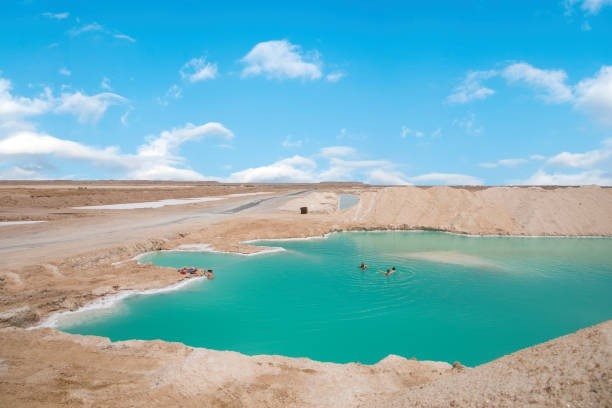
Nestled in the western part of Egypt, near the Libyan border, Siwa Oasis is one of the most enchanting and tranquil destinations in the country. This remote oasis, surrounded by vast deserts, offers a unique blend of natural beauty, ancient history, and traditional Berber culture. Known for its natural springs, salt lakes, and historical ruins, Siwa is a place where time seems to stand still, offering a peaceful escape from the bustling cities of Egypt.
🌟 Highlights of Siwa Oasis
🏰 The Ancient Temple of Amun
• Temple of the Oracle of Amun
The Temple of Amun, also known as the Oracle of Siwa, is one of the most famous landmarks in Siwa Oasis. This ancient site was once visited by Alexander the Great, who sought guidance from the oracle before embarking on his conquest of Persia. The temple, though partially in ruins, still retains its mysterious aura and provides stunning views of the surrounding desert.
🌿 Siwa’s Natural Springs and Lakes
• Cleopatra’s Bath
One of the most popular natural attractions in Siwa is Cleopatra’s Bath, a beautiful natural spring surrounded by tall palm trees. It’s said that Queen Cleopatra once bathed here, adding a sense of mystique to the place. Visitors can enjoy a refreshing swim in the crystal-clear water while surrounded by the serenity of the oasis.
• Lake Siwa
The Salt Lakes in Siwa are another stunning feature of the oasis. The high salinity of the water creates striking white crusts along the shoreline, offering a surreal landscape. The lakes also have therapeutic benefits, as the mineral-rich waters are believed to have healing properties.
🏜️ The Great Sand Sea
• Sand Dune Adventures
Siwa is surrounded by the Great Sand Sea, a vast expanse of towering sand dunes stretching across the desert. Visitors can embark on thrilling dune bashing tours or ride 4×4 vehicles across the dunes, feeling the adrenaline as you explore the mesmerizing desert landscape. You can also try your hand at sandboarding for a fun, unique experience.
🏠 Siwa’s Unique Architecture and Culture
• Traditional Berber Homes
Siwa Oasis is home to the Berber people, and its architecture is a distinctive feature of the region. The Siwan houses, made of mudbrick, are built to blend with the natural environment. The local craftsmanship is reflected in the design of the homes, which feature intricately carved doors and windows.
• Siwa Culture
The people of Siwa are known for their rich cultural heritage, which is a blend of ancient Egyptian, Berber, and Islamic influences. Traditional Siwan life revolves around agriculture, with the cultivation of dates, olives, and palm trees. The local markets are vibrant and full of handmade goods, from textiles to pottery.
🏛️ Shali Fortress
• The Old City of Shali
The Shali Fortress is an ancient mudbrick city located in the heart of Siwa. It was once the center of life in the oasis and was built by the Berbers using the local salt-and-clay material. The fortress offers panoramic views of the surrounding area, including the palm groves and salt lakes. Exploring the ruins of Shali gives visitors a glimpse into the past and the historical significance of the oasis.
🌅 Siwa’s Sunset Views
• Desert Sunsets
Siwa offers some of the most breathtaking sunsets in Egypt. Whether you’re atop a sand dune, by the salt lakes, or in the heart of the oasis, the views are magical. The desert sky turns into a canvas of vibrant colors as the sun sets behind the dunes, creating a peaceful and awe-inspiring experience.
🚗 How to Get There
• By Car: Siwa Oasis is located around 750 kilometers from Cairo, and the best way to reach it is by car or private tour. The journey takes about 9-10 hours through the desert, and the route offers beautiful views of Egypt’s landscapes.
• By Bus: There are buses from Cairo to Siwa, but they are less frequent and can be a bit long. The bus journey typically takes 10 to 12 hours.
• By Plane: Although there are no direct flights to Siwa, the nearest airport is Marsa Matruh Airport. From there, you can take a bus or private transfer to Siwa, about 300 kilometers away.
🕒 Visitor Information
• Opening Hours: Most of Siwa’s attractions are open year-round, but it’s best to visit during the cooler months from October to April. The summer months can be extremely hot, with temperatures reaching over 40°C (104°F).
• Accommodation: Siwa offers a range of accommodations, from traditional eco-lodges and guesthouses to luxury resorts. Many places are built using natural materials to blend in with the desert surroundings.
• Best Time to Visit: The ideal time to visit Siwa is during the winter months (November to February) when the weather is cooler and more pleasant for outdoor activities like exploring the ruins and enjoying the desert landscape.
💡 Travel Tips
• 💧 Stay Hydrated: The desert climate can be extremely hot and dry, so it’s important to carry plenty of water, especially when venturing out into the desert or exploring the ruins.
• 📸 Capture the Beauty: Siwa is incredibly photogenic, with its ancient ruins, natural springs, and vast desert landscapes. Don’t forget your camera to capture the unique beauty of the oasis.
• 🏜️ Desert Adventure: If you plan on exploring the desert or sand dunes, consider booking a 4×4 tour with a local guide. It’s a thrilling way to discover the hidden gems of the desert.
• 🧢 Dress for the Desert: Light, breathable clothing, a hat, and sunglasses are a must. The sun can be intense, especially during midday.
• 🌙 Stargazing: Siwa is one of the best places in Egypt for stargazing. The lack of light pollution and the clear desert sky offer spectacular views of the stars at night.
Siwa Oasis is a hidden gem that captures the essence of Egypt’s mystical desert landscapes and ancient history. From the oracle of Amun to its tranquil lakes and vibrant culture, Siwa offers an experience unlike any other. Whether you’re seeking adventure, relaxation, or a dive into Egypt’s rich past, Siwa Oasis provides a serene escape into the heart of the desert. It’s the perfect destination for those looking to explore Egypt’s unique oases and uncover the secrets of the ancient world.
📝 Local Travel Tips
- 🎟️ Buy tickets early for top attractions: Especially for tombs in the Valley of the Kings or Abu Simbel excursions.
- 🌅 Visit major sites early in the day: Avoid the midday heat and large tour groups.
- 🍽️ Eat local: Try koshari, falafel, grilled meats, and sugarcane juice for a real taste of Egypt.
- 🧴 Stay hydrated and sun-protected: The sun is strong, even in winter — bring sunscreen, hats, and reusable water bottles.
- 🧣 Dress modestly: Especially when visiting religious sites — long pants, shoulders covered for both men and women.
📌 Additional Information
- Safety: Egypt is generally safe in tourist areas. Stick to licensed guides and registered tour providers.
- Connectivity: Wi-Fi is widely available in hotels; you can buy a local SIM card for better connectivity.
- Shopping: Pick up papyrus art, alabaster souvenirs, spices, and handmade crafts from local bazaars.
- Cultural Respect: Egyptians are warm and hospitable. Learning a few words in Arabic like “shukran” (thank you) goes a long way.
✨ Final Thoughts
Egypt is more than just a trip — it’s a journey back in time. Whether you’re wandering through ancient tombs, sailing the Nile, or sipping tea in a bustling souk, Egypt immerses you in stories etched in stone and sand. With its blend of ancient wonder and modern charm, it’s a destination that stays with you long after you return.
Let Egypt’s timeless treasures and golden sun inspire your next adventure. 🏺🌅🐫

I’m Shreyash Mhashilkar, an IT professional who loves building user-friendly, scalable digital solutions. Outside of coding, I enjoy researching new places, learning about different cultures, and exploring how technology shapes the way we live and travel. I share my experiences and discoveries to help others explore new places, cultures, and ideas with curiosity and enthusiasm.






